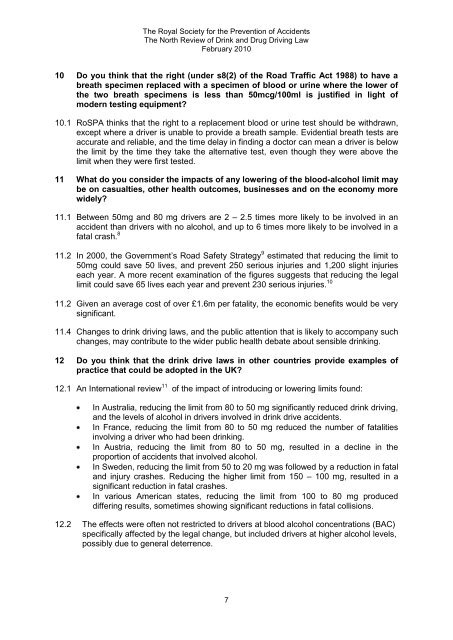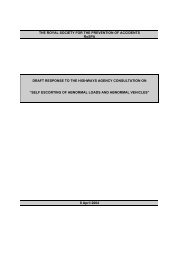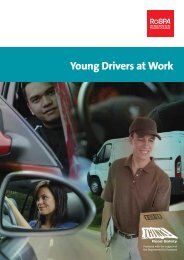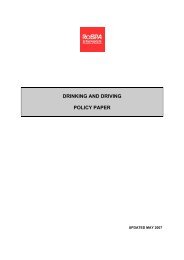The North Review of Drink and Drug Driving Laws - RoSPA
The North Review of Drink and Drug Driving Laws - RoSPA
The North Review of Drink and Drug Driving Laws - RoSPA
Create successful ePaper yourself
Turn your PDF publications into a flip-book with our unique Google optimized e-Paper software.
<strong>The</strong> Royal Society for the Prevention <strong>of</strong> Accidents<br />
<strong>The</strong> <strong>North</strong> <strong>Review</strong> <strong>of</strong> <strong>Drink</strong> <strong>and</strong> <strong>Drug</strong> <strong>Driving</strong> Law<br />
February 2010<br />
10 Do you think that the right (under s8(2) <strong>of</strong> the Road Traffic Act 1988) to have a<br />
breath specimen replaced with a specimen <strong>of</strong> blood or urine where the lower <strong>of</strong><br />
the two breath specimens is less than 50mcg/100ml is justified in light <strong>of</strong><br />
modern testing equipment?<br />
10.1 <strong>RoSPA</strong> thinks that the right to a replacement blood or urine test should be withdrawn,<br />
except where a driver is unable to provide a breath sample. Evidential breath tests are<br />
accurate <strong>and</strong> reliable, <strong>and</strong> the time delay in finding a doctor can mean a driver is below<br />
the limit by the time they take the alternative test, even though they were above the<br />
limit when they were first tested.<br />
11 What do you consider the impacts <strong>of</strong> any lowering <strong>of</strong> the blood-alcohol limit may<br />
be on casualties, other health outcomes, businesses <strong>and</strong> on the economy more<br />
widely?<br />
11.1 Between 50mg <strong>and</strong> 80 mg drivers are 2 – 2.5 times more likely to be involved in an<br />
accident than drivers with no alcohol, <strong>and</strong> up to 6 times more likely to be involved in a<br />
fatal crash. 8<br />
11.2 In 2000, the Government’s Road Safety Strategy 9 estimated that reducing the limit to<br />
50mg could save 50 lives, <strong>and</strong> prevent 250 serious injuries <strong>and</strong> 1,200 slight injuries<br />
each year. A more recent examination <strong>of</strong> the figures suggests that reducing the legal<br />
limit could save 65 lives each year <strong>and</strong> prevent 230 serious injuries. 10<br />
11.2 Given an average cost <strong>of</strong> over £1.6m per fatality, the economic benefits would be very<br />
significant.<br />
11.4 Changes to drink driving laws, <strong>and</strong> the public attention that is likely to accompany such<br />
changes, may contribute to the wider public health debate about sensible drinking.<br />
12 Do you think that the drink drive laws in other countries provide examples <strong>of</strong><br />
practice that could be adopted in the UK?<br />
12.1 An International review 11 <strong>of</strong> the impact <strong>of</strong> introducing or lowering limits found:<br />
In Australia, reducing the limit from 80 to 50 mg significantly reduced drink driving,<br />
<strong>and</strong> the levels <strong>of</strong> alcohol in drivers involved in drink drive accidents.<br />
In France, reducing the limit from 80 to 50 mg reduced the number <strong>of</strong> fatalities<br />
involving a driver who had been drinking.<br />
In Austria, reducing the limit from 80 to 50 mg, resulted in a decline in the<br />
proportion <strong>of</strong> accidents that involved alcohol.<br />
In Sweden, reducing the limit from 50 to 20 mg was followed by a reduction in fatal<br />
<strong>and</strong> injury crashes. Reducing the higher limit from 150 – 100 mg, resulted in a<br />
significant reduction in fatal crashes.<br />
In various American states, reducing the limit from 100 to 80 mg produced<br />
differing results, sometimes showing significant reductions in fatal collisions.<br />
12.2 <strong>The</strong> effects were <strong>of</strong>ten not restricted to drivers at blood alcohol concentrations (BAC)<br />
specifically affected by the legal change, but included drivers at higher alcohol levels,<br />
possibly due to general deterrence.<br />
7
















